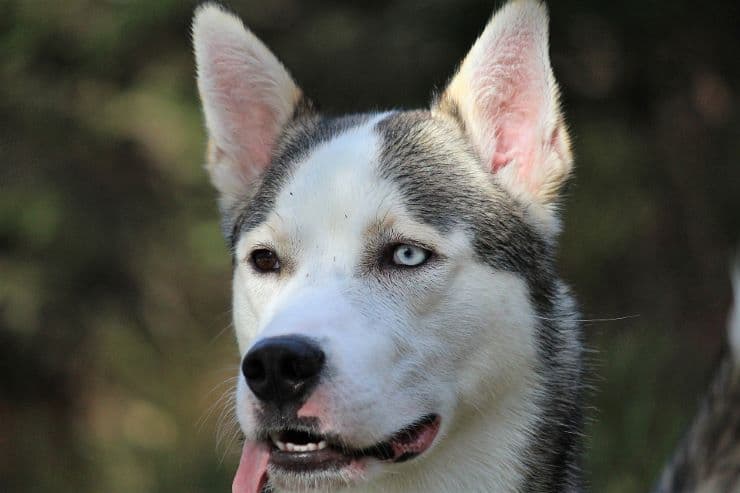Q: What is the difference between a Siberian Husky and Alaskan Husky?
Just was wondering if there is even such thing as an Alaskan Husky if there is what is the difference?
Answers and Views:
Answer by rich
There is such thing as an Alaskan husky. it's known in the mushing/dog sledding world. it's a hybrid dog bred for its speed and qualities as a sled dog. if you watch the Iditarod, many of those dogs are not Siberian Huskies or Alaskan Malamutes like most people think of when you think of sled dogs. while the AKC may not recognize it as a breed it most certainly is recognized in the racing community. I own a husky and would like to own a small team one day, however, I do like the Sibes better.

Photo Credit: MikkelBorge/Pixabay
Answer by Allie
the only difference I can assume is that the Siberian husky originated in Siberia, and the Alaskan husky is from Alaska.
technically, Alaskan huskies don't really exist though. the reason someone may say it is an Alaskan husky is that it has been mixed with other Alaskan breeds. (:
It's called an Alaskan Malamute. And Siberian Husky
Answer by Timothy
From what I gather through reading and watching video’s the Alaskan Husky is more a type of Racing sled dog. I’m thinking it’s Siberian Husky outcrossed with other breeds such as pointers and maybe greyhound in order to increase speed. Personally, if I wanted a working dog for non-racing type sledding in the arctic I’d probably choose something like a Siberian, Malamute, or Greenland Husky. Mostly cause they are actual Arctic breeds with a history of working and living in that type of environment.
Answer by Kara
Alaskan Husky Actually has its own genetic signature despite outcrossing to other breeds because they are bred for a specific purpose. They are what many working breeds you know of used to be. I'm sure if you told a hunter that a lurcher is just a mutt they would strongly disagree, as a lurcher itself is considered a type of dog to function for a specific purpose that has been developing for even a hundred years. Siberians can also be broken down into show sibes and Seppala sibes etc. And malamutes there are giant mals, woolly mals, etc. anyway Alaskan Huskies act differently than sibes for the most part but may be slightly comparable to Seppala sibes but even then they differ.
https://goo.gl/by1BND
Answer by Harleigh
The Alaskan husky is a specially bred mutt for racing purposes, a working dog. The Siberian husky is also a working dog but is AKC recognized. They aren't as fast as the Alaskan so run non-competitively in major races. The sibe can survive an arctic winter better than an Alaskan. Sibes have better feet and need less food. Alaskans are many times bred with hounds to gain speed. Siberian huskies look a certain way, and it doesn't matter what an Alaskan looks like as long as it can pull ;)
- Tips on Raising a Siberian Husky Puppy?
- What is a reasonable price for an Alaskan Husky dog?
- Siberian Husky - Is it a Dog for Me?
Answer by Joe A Want
Alaskan huskies are in part or entirely descended, depending on the exact lineage, from the native village dogs. There is a difference between the dogs from In~upiat villages and the ones from Athabascan villages. The former tend to be more aggressive and the latter is more 'domesticate' for lack of a better description. A lot of mushers have added various breeds to their lines, such as Gareth Wright. Among other breeds, he added Irish Setter and wolf to make his Aurora Huskies. Other mushers have added German Shorthaired Pointer, Labrador, Saluki, various Coonhounds, American Foxhounds, and who knows what else that could run well or added a desired feature, such as compact feet.
Answer by Art69
Wiki says: The Alaskan husky is a type of dog. It is considered a pure breed because there is a preferred type of and restriction as to ancestry; it is defined only by its purpose, which is that of a highly efficient sled dog. The Alaskan Husky is a blend of various Nordic breeds, chosen particularly for skills such as pulling and team player abilities. The Alaskan Husky does have a unique genetic signature of microsatellite-based markers that are more consistent than those found in Malamutes or Siberians.
Know better? Give your own answer to this question!
Timothy says
The comment has been moved into the body of the post.
Kara says
The comment has been moved into the body of the post.
Gina says
Not Alaskan Husky its an Alaskan Malamute.
Kara says
There are Alaskan huskies , Siberian Huskies, and Malamutes…among others
Rebekah05 says
Got the the AKC website and search breeds alphabetically. It lists all breeds of dogs.